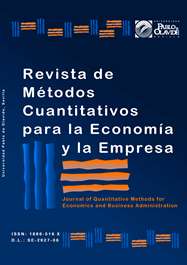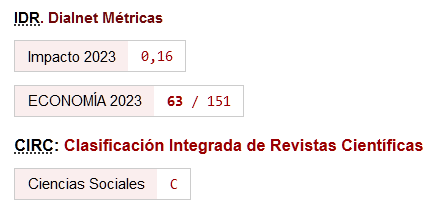Determinantes microeconómicos de la evasión tributaria empresarial en economías emergentes: el caso de Argentina
DOI:
https://doi.org/10.46661/revmetodoscuanteconempresa.5277Palabras clave:
sector informal, subdeclaración de ingresos, impuestos, corrupción, burocracia, calidad institucional, economía emergenteResumen
Este trabajo tiene por objetivo identificar los determinantes de la subdeclaración de ingresos y su evolución temporal desde la óptica de los empresarios en compañías registradas de un país emergente con alta inflación (Argentina). Se propone un modelo conceptual y se estima empíricamente mediante una regresión logística a partir de datos fusionados de secciones cruzadas independientes de los años 2010 y 2017 de las bases Enterprise Surveys del Banco Mundial. Los resultados muestran que la subdeclaración de ingresos es un fenómeno multicausal donde los impuestos pierden importancia a la luz de otros determinantes como: corrupción, regulación y burocracia, calidad de los servicios públicos y gubernamentales, probabilidad de detección, informalidad del sector e inestabilidad política. Además, los resultados reconocen las características de las empresas con mayor propensión a subregistrar las ventas (menor tamaño, venta en el mercado interno, del sector manufacturero, sin financiamiento externo, con empresarios del género masculino). La evidencia es relevante para la formulación de políticas públicas tendientes a reducir la subdeclaración de ingresos.
Descargas
Citas
Abdixhiku, L., Krasniqi, B., Pugh, G., & Hashi, I. (2017). Firm-level determinants of tax evasion in transition economies. Economic Systems, 41(3), 354366.
Abdixhiku, L., Pugh, G., & Hashi, I. (2018). Business tax evasion in transition economies: a cross-country panel investigation. The European Journal of Comparative Economics, 15(1), 1136.
Acosta, P., & Montes-Rojas, G. (2014). Informal jobs and trade liberalisation in Argentina. The Journal of Development Studies, 50(8), 1104-1118.
Allingham, M.G., & Sandmo, A. (1972). Income tax evasion: A theoretical analysis. Journal of public economics, 1(3-4), 323-338.
Alm, J., & Mcclellan, C. (2012). Tax morale and tax compliance from the firm's perspective. Kyklos, 65(1), 1-17.
Alm, J., Liu, Y. and Zhang, K. (2019). International Tax and Public Finance, 26(1), 71-102.
Alm, J., Martinez-Vazquez, J., & Mcclellan, C. (2016). Corruption and Firm Tax Evasion. Journal of Economic Behavior and Organization, 124, 146-163.
Andreoni, J., Erard, B., & Feinstein, J. (1998). Tax compliance. Journal of Economic Literature, 36(2), 818-860.
Argentina, Juzgado Federal de Córdoba (15 de agosto de 2019). Bodegas esmeralda S.A. c/ Administración Federal de Ingresos Públicos (AFIP) s/acción meramente declarativa de inconstitucionalidad. Causa 26202/2019. https://www.thomsonreuters.com.ar/es/solucionesfiscales-contables-gestion/blog-empresas/importante-fallo-vinculado-al-ajuste-por-inflacion-impositivo.html
Argentina, Poder Ejecutivo Nacional (2018). Ley 27.430. Boletín Oficial del 24 de enero 2018. https://www.boletinoficial.gob.ar/detalleAviso/primera/176831/20171229
Batra, G., Kaufmann, D., & Stone, A. H. (2003). Investment Climate around the World: Voices of the Firms from the World Business Environment Survey. Washington: The World Bank. https://openknowledge.worldbank.org/handle/10986/15143
Beck, T., Lin, C., & Ma, Y. (2014). Why Do Firms Evade Taxes? The Role of Information Sharing and Financial Sector Outreach: Why Do Firms Evade Taxes? The Journal of Finance, 69(2), 763-817.
Blanco, D. (2019). Cuccioli: El principal problema de evasión en Argentina son las facturas apócrifas. https://www.ambito.com/cuccioli-el-principal-problema-evasion-argentina-son-las-facturas-apocrifas-n5030420
Borja-Díaz-Rivillas, F., & Lindemberg-Baltazar, A.H. (2014). La moral fiscal y la búsqueda de una mayor reciprocidad entre el Estado y los ciudadanos en América Latina. En Cultura Contributiva en América Latina. México: Procuraduría de la Defensa del Contribuyente. http://www.educacionfiscal.org/files/2016-08/cultura-contributiva-en-america-latina-livro-mexico.pdf
Buehn, A., & Schneider, F. (2012). Shadow economies around the world: novel insights, accepted knowledge, & new estimates. International tax and public finance, 19(1), 139-171.
Buis, M.L. (2010). Stata tip 87: Interpretation of interactions in nonlinear models. The stata journal, 10(2), 305-308.
Castro, L., & Scartascini, C. (2015). Tax compliance and enforcement in the pampas evidence from a field experiment. Journal of Economic Behavior and Organization, 116, 65-82.
Cebula, R. J. (1997). An empirical analysis of the impact of government tax and auditing policies on the size of the underground economy: the case of the United States, 1973-94. American Journal of Economics and Sociology, 56(2), 173-185.
Chelala, S., & Giarrizzo, V. (2014). Evasión de impuestos en Argentina: un análisis experimental de la eficiencia de premios y castigos al contribuyente. Revista Finanzas y Política Económica, 6(1), 269-286.
D’hernoncourt, J., & Méon, P.G. (2012). The not so dark side of trust: Does trust increase the size of the shadow economy? Journal of Economic Behavior and Organization, 81(1), 97-121.
Dabla-Norris, E., Gradstein, M., & Inchauste, G. (2008). What causes firms to hide output? The determinants of informality. Journal of Development Economics, 85(1-2), 1-27.
De Paula, A., & Scheinkman, J. A. (2011). The informal sector: An equilibrium model and some empirical evidence from Brazil. Review of Income and Wealth, 57, S8-S26.
De Soto, H., Ghersi, E., & Ghibellini, M. (1987). El otro sendero. Bogotá (Colombia): La Oveja Negra.
Dell’anno, R. (2007). The shadow economy in Portugal: An analysis with the MIMIC approach. Journal of Applied Economics, 10(2), 253-277.
Dell’anno, R., Gómez-Antonio, M., & Pardo, A. (2007). The shadow economy in three Mediterranean countries: France, Spain and Greece. A MIMIC approach. Empirical Economics, 33(1), 51-84.
Feige, E. L. (1994). The underground economy and the currency enigma. Public Finance (Finances publiques), 49(Supplement), 119-136.
Feld, L.P., & Schneider, F. (2010). Survey on the shadow economy and undeclared earnings in OECD countries. German Economic Review, 11(2), 109-149.
Frey, B.S., & Pommerehne, W.W. (1984). The Hidden Economy: State and Prospects for Measurement. Review of Income and Wealth, 30(1), 1-23.
Friedman, E., Johnson, S., Kaufmann, D., & Zoido-Lobaton, P. (2000). Dodging the grabbing hand: determinants of unofficial activity in 69 countries. Journal of Public Economics, 76(3), 459-493.
Giarrizzo, V. (2014). Evasión fiscal en la Argentina: caracterización del contribuyente según su predisposición a cumplir con sus impuestos. En Cultura Contributiva en América Latina. México: Procuraduría de la Defensa del Contribuyente. http://www.educacionfiscal.org/files/2016-08/cultura-contributiva-en-america-latina-livro-mexico.pdf
Gokalp, O.N., Lee, S.H., & Peng, M.W. (2017). Competition and corporate tax evasion: An institution-based view. Journal of World Business, 52(2), 258-269.
Gómez, J.C., & Morán, D. (2016). Evasión tributaria en América Latina: Nuevos y antiguos desafíos en la cuantificación del fenómeno en los países de la región. Series de la CEPAL. Macroeconomía del Desarrollo, 172.
Hasseldine, J., & Hite, P. A. (2003). Framing, gender and tax compliance. Journal of Economic Psychology, 24(4), 517-533.
Hibbs, D.A., & Piculescu, V. (2010). Tax toleration and tax compliance: How government affects the propensity of firms to enter the unofficial economy. American Journal of Political Science, 54(1), 18-33.
Ihrig, J., & Moe, K.S. (2004). Lurking in the shadows: the informal sector and government policy. Journal of Development Economics, 73(2), 541-557.
Instituto Argentino de Análisis Fiscal (IARAF) (2019). Vademécum tributario argentino 2019: 163 tributos legislados por Nación, Provincias y Municipios. https://www.iaraf.org/index.php/informes-economicos/area-fiscal/277-informe-economico-48
Johnson, S., Kaufmann, D., & Shleifer, A. (1997). The Unofficial Economy in Transition. Brookings Papers on Economic Activity, 1997(2), 159-239.
Johnson, S., Kaufmann, D., & Zoido-Lobaton, P. (1998). Regulatory discretion and the unofficial economy. The American Economic Review, 88(2), 387-392.
Johnson, S., Kaufmannb, D., Mcmillan, J., & Woodruff, C. (2000). Why do firms hide? Bribes and unofficial activity after communism. Journal of Public Economics, 76, 495-520.
Kastlunger, B., Dressler, S. G., Kirchler, E., Mittone, L., & Voracek, M. (2010). Sex differences in tax compliance: Differentiating between demographic sex, gender-role orientation, & prenatal masculinization (2D: 4D). Journal of Economic Psychology, 31(4), 542-552.
La Porta, R., & Shleifer, A. (2008). The Unofficial Economy and Economic Development. Brookings Papers on Economic Activity, otoño, 275-352.
Lackó, M. (2000). Hidden economy–an unknown quantity? Comparative analysis of hidden economies in transition countries, 1989–95. Economics of Transition, 8(1), 117-149.
Loayza, N. V. (1996). The economics of the informal sector: a simple model and some empirical evidence from Latin America. Carnegie-Rochester conference series on public policy, 45,129-162.
Lohr, S. L., & Liu, J. (1994). A comparison of weighted and unweighted analyses in the National Crime Victimization Survey. Journal of Quantitative Criminology, 10(4), 343-360.
Long, S., & Freese, J. (2001). Regression Models for Categorical Dependent Variables Using Stata. Texas: College Station, Stata Press.
Medina, L., & Schneider, F. (2017). Shadow economies around the world: New results for 158 countries over 1991-2015. CESifo Working Paper Series No. 6430. https://ssrn.com/abstract=2965972
North, D.C. (1990). Institutions, institutional change and economic performance. Nueva York: Cambridge University Press.
Norton, E.C., Wang, H., & AI, C. (2004). Computing interaction effects and standard errors in logit and probit models. The Stata Journal, 4(2), 154-167.
Nur-Tegin, K.D. (2008). Determinants of Business Tax Compliance. The B.E. Journal of Economic Analysis and Policy, 8(1), 1-28.
OECD, CAF & ECLAC (2018). Perspectivas económicas de América Latina 2018: Repensando las instituciones para el desarrollo. Paris: OECD. https://doi.org/10.1787/leo-2018-es
Pecho-Trigueros, M., Longinotti, F. P., & Vecorena, J. S. (2012). Estimación del Incumplimiento Tributario en América Latina. Centro Interamericano de Administraciones Tributarias. http://www.estimacionestributarias.com/archivos/Incumplimiento%20AL%20pecho_pelaez_sanchez.pdf
Pedroni, F., Briozzo, A., & Pesce, G. (2018). Determinantes de la subdeclaración de ingresos en empresas latinoamericanas. Trabajo presentado en XXIII Reunión Anual de Red PyMEs Mercosur. Buenos Aires, Mar del Plata.
Pedroni, F., Pesce, G., & Briozzo, A. (2019). Estimación y determinantes de la subdeclaración de ingresos en Argentina: percepción de los profesionales en ciencias económicas. Trabajo presentado en la XIX International Finance Conference (IFC-2019). Córdoba, Córdoba.
Perry, G.E., Maloney, W.F., Arias, O.S., Fajnzylber, P., Mason, A.D., Saavedra-Chanduvi, J., & Bosch, M. (2007). Informalidad: escape y exclusión. Estudios Banco Mundial sobre América Latina y el Caribe. Washington, DC: Banco Mundial. http://siteresources.worldbank.org/INTLACINSPANISH/Resources/SP_lacf_Overview.pdf
Pesce, G., Speroni, C., Etman, G., Rivera, C., Briozzo, A., & Vigier, H. (2014). Informalidad, presión tributaria y cumplimiento fiscal en las PyMEs. En Grandes desafíos para pequeñas empresas: informalidad, financiamiento e información. El caso de las PyMEs de Bahía Blanca. Bahía Blanca: EDIUNS. Serie Extensión.
Pfeffermann, D. (1993). The role of sampling weights when modeling survey data. International Statistical Review, 317-337.
Putniņš, T.J., & Sauka, A. (2015). Measuring the shadow economy using company managers. Journal of Comparative Economics, 43(2), 471-490.
PWC and World Bank Group (2019). Paying Taxes 2019. https://www.pwc.es/es/publicaciones/legal-fiscal/assets/pwc-paying-taxes-2019.pdf
Santa María, S., & Rozo, S. (2009). Análisis cualitativo y cuantitativo de la informalidad empresarial en Colombia. Desarrollo y Sociedad, 63, 269-296.
Sarghini, J., Lódola, A., & Moccero, D. (2001). El dilema de la economía informal: evidencias y políticas. Cuadernos de Economía, (59). https://eco.mdp.edu.ar/cendocu /repositorio/00811.pdf
Schneider, F. (1997). The shadow economies of Western Europe. Economic Affairs, 17(3), 42-48.
Schneider, F. (2016). Estimating the size of the shadow economies of highly-developed countries: Selected new results. CESifo DICE Report, 14(4), 44-53.
Schneider, F., & Boockmann, B. (2017). Die Größe der Schattenwirtschaft. Methodik und Berechnungen für das Jahr 2017. Johannes Kepler Universität. Institut für Angewandte Wirtschaftsforschung (IAW). http://www.iaw.edu/index.php/aktuelles-detail/734.
Schneider, F., & Enste, D. H. (2000). Shadow economies: size, causes, & consequences. Journal of economic literature, 38(1), 77-114.
Schneider, F., & Enste, D. H. (2013). The shadow economy: An international survey. Nueva York: Cambridge University Press.
Siqueira, A.C.O., Webb, J.W., & Bruton, G.D. (2016). Informal Entrepreneurship and Industry Conditions. Entrepreneurship Theory and Practice, 40(1), 177-200.
Slemrod, J., & Weber, C. (2012). Evidence of the invisible: toward a credibility revolution in the empirical analysis of tax evasion and the informal economy. International Tax and Public Finance, 19(1), 25-53.
Solon, G., Haider, S.J., & Wooldridge, J. (2013). What are we weighting for? National Bureau of Economic Research, Working Paper No. 8, Washington, DC.
Straub, S. (2005). Informal sector: the credit market channel. Journal of Development Economics, 78(2), 299-321.
Tanzi, V. (1983). The underground economy in the United States: annual estimates, 1930-80. Staff Papers, 30(2), 283-305.
Tedds, L. M. (2010). Keeping it off the books: an empirical investigation of firms that engage in tax evasion. Applied Economics, 42(19), 2459-2473.
Torgler, B. (2011). Tax morale and compliance: review of evidence and case studies for Europe. World Bank Policy Research Working Paper No. 5922. http://documents.worldbank.org/curated/en/862221468282310839/pdf/WPS5922.pdf
Torgler, B., & Valev, N.T. (2010). Gender and public attitudes toward corruption and tax evasion. Contemporary Economic Policy, 28(4), 554-568.
Villar, L., Briozzo, A., & Pesce, G. (2015a). Determinantes de la informalidad en las microempresas de la Argentina. En Anales de la XX Reunión Anual de Red PyMEs Mercosur. Buenos Aires, Bahía Blanca.
Villar, L., Briozzo, A., & Pesce, G. (2015b). El efecto de la informalidad en las decisiones de financiamiento de las microempresas. En Anales de las XXXV Jornadas Nacionales de Administración Financiera (SADAF). Córdoba, Vaquerías.
Vuletin, G.J. (2008). Measuring the informal economy in Latin America and the Caribbean. International Monetary Fund. Working Paper No. 2008/102. https://www.imf.org/en/Publications/WP/Issues/2016/12/31/Measuring-the-Informal-Economy-in-Latin-America-and-the-Caribbean-21898
Webb, J.W., Tihanyi, L., Ireland, R.D., & Sirmon, D.G. (2009). You say illegal, I say legitimate: Entrepreneurship in the informal economy. Academy of Management Review, 34(3), 492-510.
Williams, C.C., & Horodnic, I.A. (2016). Cross-country variations in the participation of small businesses in the informal economy: An institutional asymmetry explanation. Journal of Small Business and Enterprise Development, 23(1), 3-24.
Williams, C.C., & Kedir, A. (2018). Evaluating competing theories of informal sector entrepreneurship: A study of the determinants of cross-country variations in enterprises starting-up unregistered. The International Journal of Entrepreneurship and Innovation, 19(3), 155-165.
Williams, C.C., Shahid, M.S., & Martínez, A. (2016). Determinants of the Level of Informality of Informal Micro-Enterprises: Some Evidence from the City of Lahore, Pakistan. World Development, 84, 312-325.
Winship, C., & Radbill, L. (1994). Sampling weights and regression analysis. Sociological Methods and Research, 23(2), 230-257.
World Bank Group (2019a). Argentina overview. https://www.bancomundial.org/es/country/argentina/overview. Accessed December 2019.
World Bank Group (2018). Enterprise Surveys. www.enterprisesurveys.org. Accessed May 2018.
World Bank Group (2019b). World Bank Open Data. https://data.worldbank.org/. Accessed December 2019.
Publicado
Cómo citar
Número
Sección
Licencia

Esta obra está bajo una licencia internacional Creative Commons Atribución-CompartirIgual 4.0.
El envío de un manuscrito a la Revista supone que el trabajo no ha sido publicado anteriormente (excepto en la forma de un abstract o como parte de una tesis), que no está bajo consideración para su publicación en ninguna otra revista o editorial y que, en caso de aceptación, los autores están conforme con la transferencia automática del copyright a la Revista para su publicación y difusión. Los autores retendrán los derechos de autor para usar y compartir su artículo con un uso personal, institucional o con fines docentes; igualmente retiene los derechos de patente, de marca registrada (en caso de que sean aplicables) o derechos morales de autor (incluyendo los datos de investigación).
Los artículos publicados en la Revista están sujetos a la licencia Creative Commons CC-BY-SA de tipo Reconocimiento-CompartirIgual. Se permite el uso comercial de la obra, reconociendo su autoría, y de las posibles obras derivadas, la distribución de las cuales se debe hacer con una licencia igual a la que regula la obra original.
Hasta el volumen 21 se ha estado empleando la versión de licencia CC-BY-SA 3.0 ES y se ha comenzado a usar la versión CC-BY-SA 4.0 desde el volumen 22.










